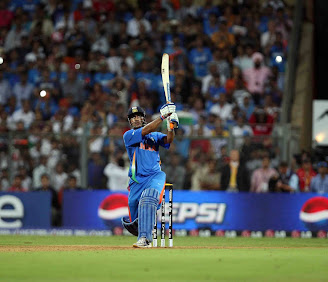It appeared almost inevitable that India would win the 2011 World Cup. A billion Indians seemed to believe that the team would certainly win, and the team itself desperately wanted to win it for its billion fanatical followers and for one peerless and inspirational representative of God himself, Sachin Tendulkar. The team had been steadily ascending the ladder of success since its heart-wrenching ouster from the 2007 World Cup. One by one, things began falling into place. Tendulkar toiled not only to regain the magical touch of yore but also to scale peak after peak. An efficient back-up staff led by the taciturn and hard-nosed Gary Kirsten engineered the side into a fighting machine. A young, razor-sharp, unflappable and versatile skipper Mahendra Dhoni arrived to steer the ship deftly through calm as well as stormy seas.
Blessed with arguably the greatest batting line-up in history, the team crafted one success after another, rising to no. 1 status in Test matches for the first time in its chequered history of 78 years, hovering around that position in One-day Internationals as well, holding its own at home as well as overseas, and all this after having won the inaugural ICC World Twenty20 that same year of 2007. The victorious side defied conventional wisdom by clinching matches and series on the strength of its powerful batting, either posting unattainable totals or chasing down impossible targets. There was always enough depth as well as bench strength to tide over even acute crises, and to cover up for the sketchy and often profligate bowling. The captain and team management made skillful use of the embarrassingly limited bowling resources, which ultimately proved adequate in home conditions. The much-derided fielding proved equal to the task, and the end result was an inspired outfit that carried the day despite a bit of a stutter in the early stages. Even these hiccups had a silver lining, for they helped fine-tune the playing eleven and to temper the arrogance of the middle-order batsmen.
There were other fancied sides too, the Sri Lankans, favoured in familiar conditions, with strong batting and balanced bowling; the South Africans, whose day some experts believed had finally come, boasting the best pace attack in the world, a complete bowling line-up on paper, replete with allrounders, and a fine array of batsmen to go with their customary top-class fielding; and the Australians, never ones to be counted out as they showed in 2007 despite sliding down the order and obvious depletion in resources, still possessing top-quality fast bowlers but little else. The dark horses were Pakistan, unpredictable as ever, and they did threaten all the way until their ouster by the relentless Indians in an emotionally-charged semi-final.
On behalf of the minnows, the heartening performance came from the plucky Irish along with a glorious hand by Holland’s Ryan ten Doeschate. This itself makes out a case for the inclusion of some associate member nations in the future World Cups. The idea to have just ten teams is perhaps a sound one but the bottom two teams among those with One-day international status should compete in the ICC qualifying tournament with the associate members to earn the right to play in the World Cup.
Despite the odd flutter, the eight top teams took their appointed places in the quarter-finals. As expected, that is where the real action began. After Pakistan disdainfully swept aside the once-mighty West Indies, India stopped the incredible Cup-winning run of an Aussie outfit in decline. Then came possibly the biggest shock of the tournament. The unheralded and grossly underrated Kiwis skittled out the Proteas to add yet another chapter to the bemusing saga of a handsome-looking side that invariably flatters to deceive in this showpiece event. To complete the picture, Sri Lanka were as contemptuous of England as Pakistan were of the West Indies earlier.
There were, not surprisingly, three sub-continental teams in the semi-finals. New Zealand did battle hard, as is their wont, but Sri Lanka were too good in the end. The Kiwis have now played six of the ten semi-finals without once breaching this penultimate barrier. The other semi-final was really a war and a carnival rolled into one, simply the most heart-stopping sporting event held anywhere. India prevailed over Pakistan in a most curious encounter, and the fireworks at the end would have one believe that the Cup itself had been won that night.
It was an engrossing final but a relatively sedate affair. Sri Lanka were worthy opponents, equalling Australia’s highest losing score of 1975 in a World Cup final. India, irresistible as they were by now, cruised to the title amid wild jubilation. Dhoni’s emphatic hit over the long-on boundary with plenty to spare only reaffirmed the belief of so many. India became the first team to win the World Cup on home soil, the crowning glory to Sachin Tendulkar’s astonishing career and to the team’s triumphant run of recent years.
The final:
Wankhede Stadium, Mumbai, 2 April 2011
India won by 6 wickets
Sri Lanka: 274 for 6 wickets in 50 overs (Tillakaratne Dilshan 33, Kumar Sangakkara 48, Mahela Jayawardene 103 not out, Nuwan Kulasekara 32)
India: 277 for 4 wickets in 48.2 overs (Gautam Gambhir 97, Virat Kohli 35, Mahendra Singh Dhoni 91 not out)
Man of the Match: Mahendra Singh Dhoni
Player of the Tournament: Yuvraj Singh
(Excerpt from Indra Vikram Singh's book 'Crowning Glory'. The author can be contacted on email singh_iv@hotmail.com).
Follow
his blogs:
https://singhiv.wordpress.com/







